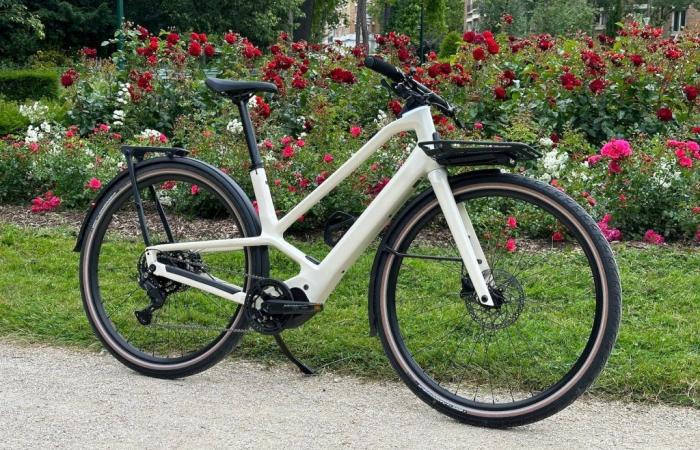It is surely Orbea’s most advanced urban e-bike, in any case the most high-end. With Diem, the cooperative from the Spanish Basque Country, wants to show once again that its atypical model in the sector of major international brands is not an obstacle to the design of well-thought-out bicycles, quite the contrary.
With the Diem, it starts with its frame, certainly the most remarkable element (in every sense of the word) of the machine. Called “Diamond Glide”, it incorporates a very “sloppy” horizontal tube which almost brings it closer to an open frame. Orbea has pushed the attention to detail very far by grinding all the welds for an almost entirely smooth finish, apart from three visible points on the side of the bases and the stays.
However, they are clean and almost invisible under the paint. The latter is also perfectly applied, our trial version in “ivory white” color looks great and did not fail to turn a few heads along our travels. It is not for nothing that it has also just been rewarded with the iF Design and Red Dot awards.
Ultra pleasant to drive on a daily basis
Rarely, the Mallabia brand did not choose aluminum for the fork of this Diem, but carbon. We thus gain in weight, rigidity, steering precision, but also in comfort thanks to the vibration absorption capabilities of this material. Large 29-inch wheels complete the running gear, fitted with excellent 50 mm section Vittoria e-Randonneur tires with impeccable grip.
And suffice to say that this combination gives the Diem almost enjoyable road behavior. Despite its weight of 23.6 kg in size M (ours), the bike is terribly dynamic and precise. You find yourself leaning into turns much lower than with other competing models, without ever losing confidence. We are well helped in this by the efficient Shimano 160 mm hydraulic brake discs, biting and effective, even in wet weather.
Despite its playful side, the Diem does not forget the practical aspect, quite the contrary. Both mudguards go low enough on the wheels to be effective. At the rear is attached a MIK and Ortlieb compatible luggage rack supporting up to 20 kg of load. Very minimalist, it can be replaced when ordered by a more massive 30 kg model, for an additional 30 euros.
The 10 kg front luggage rack costs 90 euros on our entry-level Diem 30 (3,800 euros). However, it is offered by default on the high-end Diem 10 (5,600 euros), but it is possible to delete it when ordering to obtain a discount of 90 euros on its total price.
Still in the practical vein, two eyelets are placed on the diagonal tube to screw in a bottle cage or an anti-theft attachment. The stem comes with an SP Connect mount to attach a smartphone equipped with a compatible case. A very good idea, but the location is unfortunately too low and too vertical to make the device’s screen perfectly visible.
A detail perhaps, but annoying during use and sometimes even unsafe, it takes time to lower your head so low, preventing you from looking in front of you. On the other hand, Orbea thought of placing a USB-C socket at the base of the stem to easily charge the smartphone while riding.
A multitude of practical details
The lighting has also been carefully studied and integrated. In the rear mudguard, the very elegant red border intensifies its brightness when you slow down suddenly. Be careful though, it is not connected to the brake system and uses an accelerometer for this. It is therefore not legally a real stop brake. At the front, an arcuate position light crowns the stem, so it is visible in front and on the sides.
It stays on permanently, as soon as the bike is powered on. It is complemented by a powerful Supernova headlight placed either in front of the handlebars or under the front rack if installed. It turns on automatically when darkness sets in. With a power of 500 lumens, it is already very effective, but can be optionally supplemented by a version with two positions (+70 euros on our Diem 30, included on the Diem 10): low beam (also 500 lumens) and high beam (1,000 lumens).
This is the one we had on our test machine and the system makes all the difference in the complete night. A choice to take into consideration if you often drive on very poorly lit roads. To finish on practical issues, Orbea has also provided a location for a tracker (AirTag type for example), located under the crankset, inside the motor housing. Simply disassemble it with two screws to place it there and make it perfectly invisible.
When it comes to comfort, our Diem 30 test does not include any suspended seat post by default. But here too, it is possible to add it to the order by choosing between two models with respective travel of 100 or 125 mm (+ 108 euros each). Here too, you will have understood, the option is included in the high-end Diem 10. Despite its absence, we didn’t find Diem 30 uncomfortable. By choosing the right pressure, the big tires already do their job well in this area, not to mention the frame design. The riding position can be influenced by the handlebars chosen.
By default, the Diem 10 offers a model with a rise of 54 and a width of 700 mm. Our model is equipped with the sportier version with a rise of 0 and a width of 720 mm (at no extra cost). It thus implies a more committed forward position. Useful for gaining pedaling power, but less comfortable. Another point to emphasize, its width seemed a little too large to us to sometimes slip through traffic.
Shimano motor performance
With such a bike, overall very well thought out and so efficient, Orbea should not have missed out on the choice of electric motorization. It is therefore Shimano which equips the Diem range, in this case an EP-600 model on our Diem 30 version. Here again, the Diem 10 differs by integrating an EP-801; more compact and lighter at 300 grams, it is more intended for VTTAE use, but nevertheless presents the same torque of 85 Nm as that which occupies us on our test bike.
With its know-how in this area, the Japanese brand is one of Bosch’s main competitors in the field of central motors. We appreciate the comfort of this type of motor placed at the level of the crankset, always more responsive and powerful than those placed in the hub of the rear wheel. However, it is not Bosch who wants it. Despite very good overall performance and above all sufficient power to climb the steepest slopes without difficulty, the EP-600 suffers from two faults.
The first comes from the lack of progressiveness in stopping the assistance once 25 km/h is exceeded: we feel the slight jerk due to its cut-off, it is less fluid than on the side of the German manufacturer which controls this Perfectly. The second comes from the difficulty in taking the bike once this speed limit has been crossed. You have to make a very significant effort to be rewarded with dignity; it’s hard to gain a few extra kilometers/hour.
Customizable support and excellent autonomy
Without a screen on the handlebar control, you must use the E-Tube Ride application to benefit from information concerning the bike and navigation. Here again unfortunately, the Asian is not up to par with its European competitor. The application is not the most intuitive, multiplying screens with almost the same functions.
On the other hand, the navigation is not up to standard since route recalculation simply does not exist. If you deviate from the indicated route, you will have to catch it yourself. On the other hand, the summary of recorded routes is extremely complete and can be synchronized with Strava.
Fans of customization will be delighted to know that it is possible to finely adjust the assistance modes. But for this, you will have to go through a second application, E-Tube. There too, we had simpler times. We can also regret that only three assistance modes are available (Eco, Trail and Boost). What is clearly missing here is an automatic mode which adapts itself to the effort required.
On the other hand, this Shimano motor manages its electricity consumption extremely well. We were thus able to reach 100 kilometers of autonomy in Eco mode and a good fifty in Boost mode. We therefore do not have to think about recharging the battery daily (here a 540 Wh Orbea in-house model), for example when using bicycles. This will only be done via the socket located at the bottom of the diagonal tube since the accumulator is not removable. A necessarily double-edged choice. Practical, since it avoids having to carry the battery around with you; but disqualifying all those who live on an upper floor since you need to be able to bring the bike close to a power outlet.
To not miss any news from 01net, follow us on Google News and WhatsApp.






